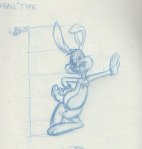Here we go, now we are doing full bodies! All of the characters drawn are derived from the pear shape – it seems like a pretty versatile shape for cartoon characters!
Check out the lesson here: http://johnkstuff.blogspot.ca/2006/05/animation-lesson-4-2-legged-characters.html
Here’s my work on this lesson. Some of the hands are a bit messed up but I looked ahead and there is a lesson on hands later.:
-Rob






This is going well. The more (and the quicker) you can check your accuracy and proportions the better. In that regard I’d recommend either drawing on a wacom tablet or printing out the images and checking them on a lightbox (just make a mark of how big part of the drawing should be before you start (eg the head or whole body). That way you can check easier without having to scan every time. You will be able to accurately check 10x as often and therefore improve much quicker.
Also start, by just drawing and checking the construction at first so you can check more often and improve your learning speed. Lots of feedback is the key. If you are not already, another level of challenge is to draw the picture at a different scale and/or not directly aligned with you drawing horizontally/vertically (once you can draw them well without these additions).
Once you get comfortable with copying, the next stage is to practice from memory. This can be tough, so just start with small amounts (ie just a few features or some construction) and check often. This will make you much more aware of which parts you understand or were just copying blindly.
Beyond that is designing and inventing you own variations. Again, this can be very mentally challenging and often tiring at first. Start with small variations such as maybe changing the position of a limb or part of an expression of a character. Have the original drawings as reference in front of you. Still check with overlays your proportions etc against an original drawing. As you get better start combining features from a few drawings / other references or work out logically how something should look when turned etc. As your mental library of knowledge increases, you will eventually be able to invent a drawing in any pose.
With even more practice, you will be able to invent drawings without needing to check so often and can work more based on memory. At this stage you are basically at a level of strong professional competence. It takes many, many years of hard practice to get to this stage (even a decade or more).
So keep this development in mind as you work though the course. Its not so much that you will get to the last lesson and be a competent cartoonist. Its more that each of these lessons point out important aspects of the training from which you can design you own practice routine and keep working at it (slowly progressing at any aspect you focus on).
I hope this grand overview helps you keep things in perspective. Keep in mind also that this will only help with drawing, not storytelling or anything else you may be interested in.
I’m a bit further along the path but I still have a long way to go.
Sincerely
Nick
PS. A good way to learn about how features move when turned is to boil an egg, draw the Preston Blair egg face from lesson one on it (with construction lines) take a systematic set of photos of it from all angles (straight on, up, down, ¾ views, side views etc) and then create a grid of it in photoshop with the straight on view in the centre. This way you can theorise and see how foreshortening works on a curved surface and practice by copying and from memory. Or you can get a wooden egg or build an egg from clay. Drawing on a ping pong ball can also help. Also drawing directly from the egg without taking photos.
I’m sure I’ve thrown way too much info at you, but best of luck going forward. It doesn’t have to be full on.
Wow! Thanks so much for the info! I will make use of it.
I have been planning to get an egg after doing the first exercise but haven’t gone out to grocery shop recently. I think rather than hard boil it I may drain the yolk like when Easter eggs are made.
Currently I am drawing using the computer monitor as the reference and I am drawing at a desk. Often I am altering the scale of the images so I can get more use out of the page. I have been trying to remember the principles and apply them in other things that I am doing. Sometimes I need to get down ideas quickly so I can’t go into full on construction but when I have more time I am able to come out with a better drawing in the end using construction.
I totally agree that I still have a lot to learn about storytelling and there is more to it all than just drawing well. I think that drawing well is a good place to start though, right? I think that the course John has made looks great and will help me in my development.
I will try some of my own variations as per your suggestion. It would be cool to have that kind of a mental library that you speak of.
I will look into doing this stuff at a light table since you are correct, it is time consuming to scan stuff all of the time!
-Rob